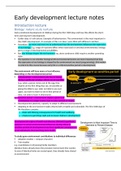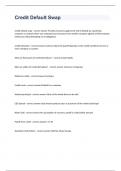Early development lecture notes
Introduction lecture
Biology: nature vs./& nurture
Socio-emotional development of children during the first 1000 days and how this affects the short-
term and long-term development.
Earlier days: it’s all nurture. Example of behaviourism. The environment is the most important in
the child’s development. An example of this is in bees’ same DNA with different nutrition.
Nowadays: we more and more try to understand how the environment influences the expression
of our biology. E.g. range of reactions differs when restricted or enriched environmental, biology
gives a range of developmental possibilities.
But also biology shapes the environment: eg. down syndrome child requires another parenting
style.
The question is not whether biological OR environmental factors are more important but how
the expression of our biology is shaped by the environment we meet (programming). (this notion
is central to this course because early life is a critical/sensitive period in development.
The environment will have more or less influence
depending on the developmental period.
Critical period = environment only has an impact
during a particular window; effects are irreversible.
(e.g. when a goose comes out of the egg, they
imprint on the first thing they see, irreversible or
gluing the kitten’s eye, later not able to see ever
again, you have to learn to see in that period of
time, not able to learn it afterwards).
Sensitive period = environment shapes a given trait
or behaviour to a larger extent than in other periods or stages.
Developmental plasticity: capacity to adapt to different environments
Adapting to the environment makes infants both versatile and vulnerable. The first 1000 days of
life therefore contains:
o Risks with lifelong consequences for health and wellbeing
o Chances to get things right and to boost children's development
Developmental origins of health and diseases (DOHaD) hypothesis =
exposure to certain environmental influences during critical or
sensitive periods of development may have significant consequences
on an individual’s short and long-term health.
To study gene-environment contributions to individual differences
Adoption studies = compare character
Twin studies
e.g. resemblance in IQ among family members.
Identical twins already share the prenatal environment (the womb).
So even if identical twins are reared apart, they already have shared
an environment.
,Chorionic arrangements
Dichorionic twins = separate placentas and separate
fetal circulations. Can be identical or fraternal twins
Monochorionic twins = one placenta and one fetal
circulation. Can only be identical twins.
o Greater concordance for these twins on IQ scores,
personality scores etc.
Lecture 1: prenatal development
Prenatal development
Teratogens = agents that cause deviations (afwijkingen) during prenatal development (teratology
or developmental toxicity). Can cause structural malformations and manifestations such as
growth retardation and delays in mental development.
o Thalidomide = an anti-emetic (anti-braakmiddel) drug to treat morning sickness over 10.000
children were born with severe malformations to the limbs (phocomelia): around 40% of them
died around birth. Took quite some time for the doctors to make a connection between the drug
and the malfunctions.
Led to the development of greater drug regulation, especially during pregnancy and
monitoring in many countries. Danger of not testing beforehand. Still relevant because of
covid-19 vaccines.
Animal studies on nutrient (voedingsstof)
Animal studies provide experimental evidence: the case of prenatal diet. What is more
important: prenatal or postpartum nutrition or combination of both? In the experiment,
the rats on the poor diet+western diet lived the shortest (baby receives cues on the poor
diet, but ends up in fatty western diet)
o Explanationon for this: Match-Mismatch model = evolutionary model that explains
how a developing fetus adapts in anticipation of the postnatal environment as a
result of cues experienced prenatally.
Thus offspring exposed to a poor diet / less food in utero (baarmoeder)
adapt to enviroment with less food to increase the chances for survival and reproduction.
o Provides evolutionary basis for developmental programming, as we can adapt to changing
environments.
o Developmental mismatch: potential cost/ risk of developmental programming.
Occurs when environmental cues in early life have limited validity (so the fetus anticipates an
post-natal enviromenent that is not going to happen) and thus adaptive responses fail to
correctly predict future enviormental conditions. E.g. if you are prepared for an enviroment
with less food and you were born in an enviroment with much fat, you will become obese
because you are prepared to use each foodintake to the maximum because of those early
cues.
Exposure to poor diet in humans: the Dutch Famine Study
During the Hunger winter daily ration of calories was around 400-800. Tessa Roseboom: The Dutch
Winter Hunger Study. Results:
Time of exposure to the mall nutrition matters:
, During famine conceived and born after the famine
were normal weight because mothers were
probably better fed in the later trimesters.
All children exposed to the famine were effected
but late and mid development station you saw
effect on birthweight but if you follow the children
over time, you see that the children in their early
development (first 3 months, the most organs are
formed in this station) effected by famine, had to
most negative outcomes.
Future effects on later health and these dependent of time of development the child was in
during the famine.
Finding seem to be not mediated through birth weight:
Different from David Baker (birth weight predictor for health)
To note: an effect of exposure to prenatal stress, exposure to cold and/or war cannot be ruled out.
But very likely that that is not the explanation for all the results (so maybe both have effect). Also
selection bias might have played a role (famine effected the fertility, mortality, child wish, raped and
forced to give birth, selective survival of embryos)
In sum, poor diet during pregnancy can have a negative effect on the offspring’s development. Still
relevant today because many countries have famine still nowadays.
Research: improving women’s diet quality preconceptionally and during gestation. A daily snack
provided additional green leafy vegetables before conception and throughout pregnancy had no
overall effect on birth weight. Per-protocol analyses = only look at the subgroup of participants that
followed to protocol / did the intervention. In these the healthy snack increased birth weight if the
mother was supplemented more than 3 months before conception and was not underweight.
Prenatal stress and anxiety
Focus is less on depression. Because found that anxiety and stress has more effect. And different
working mechanism pathology between anxiety and depression on the child.
How to study:
1. Ask mothers using questionnaires
The estimation of the percentage of woman experiencing prenatal stress varies widely.
o 8-12% of pregnant women meet criteria for a mental disorder, commonly an anxiety or
mood disorder.
o Underestimation? In a large-scale community study using self-reports about 30% of
pregnant women reported some type of stress.
Child outcomes:
o More negative affectivity, including crying
o More behaviour problems, including externalizing problems, internalizing problems,
social behaviour problems and psychiatric symptoms
o Worse cognitive outcomes, including working memory and IQ (small correlation)
Problems with this: reporter bias, studying stress or genes? And also struggling with timing
of when to report because stability when you ask only in each trimester. Stress is more
stable. No 1 whole trimester a disaster, these are moments.
2. Investigate exposure to life events during pregnancy
, Includes life events such as death of a relative, accidents or life-threatening illness of a
relative. Sudden or not?
Possibility to tease apart, to some extent (!)
o Timing of life event
o Objective vs. subjective stress
Child outcomes: (teacher report is a more objective way to get this information)
o More ADHD symptoms
o More behaviour problems
3. Investigate exposure to natural disasters during pregnancy e.g. 9/11 or an ice storm
Objectivity vs. subjectivity
o Timing of life event: often suddenly happen. Problem with later on reporting on the
event because during reporting is not possible.
Child outcomes
o Less motor development
o Less cognitive development like IQ and language development
o More negative affectivity
Important to note:
Maternal stress and anxiety seem to have more impact than depression.
Both sexes seem to be impacted, but there are also sex-specific effects.
Not all studies find effects! Publication bias? Reporter bias?
Gestational (zwangerschap) timing seems to matter, but more research needed.
Not all associations are investigated over time and/or persist over time. Longer studies are
important.
No causality can be assumed. What about genes? What about maternal postpartum distress?
Parenting quality?
Not only brain and behaviour, but child health seems to be also impacted.
Research of Roseriet Beijers
After controlling for many confounders, prenatal anxiety and stress predicted:
More child respiratory illnesses (9.3%)
More general illnesses (10.7%)
More skin illnesses (8.9%)
More antibiotic use (7.6%)
But not digestive ilnesses
Follow up study:
Some but not all associations remain
Late pregnancy anxiety and cortisol respiratory & digestive illnesses till age 3.
More maternal prenatal stress more prescribed antibiotics between 1y-6y.
No associations with skin or general illnesses.
Covid-19-crisis research
Research on people with child wish, pregnant at that time, or parents of young babies under the 6
months. Comparing anxiety and depression symptoms before and during COVID-19.
On depression: the mean increased and raise clinical cutoff, so more
in the need for clinical help.





